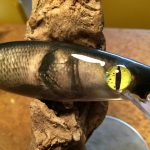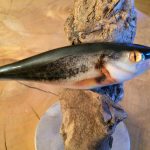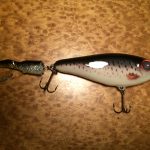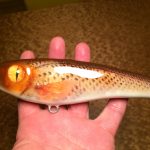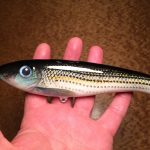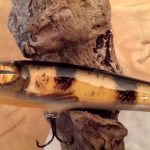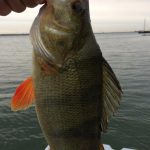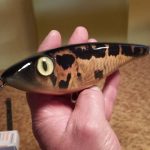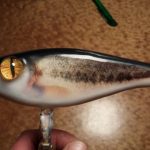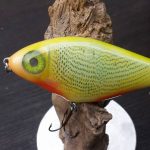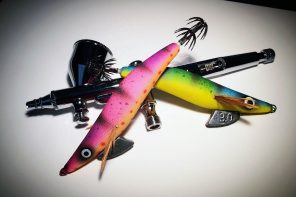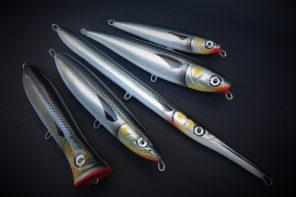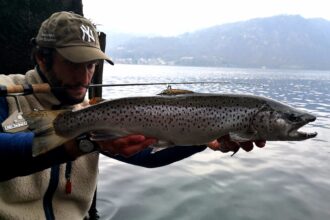A guardare bene le sue esche ci si perde nelle livree curatissime che rasentano iperrealismo. Si concentra soprattutto su jerk da luccio (una delle sue prede preferite insieme ad altri pinnuti della Renania) e, se le forme sono piuttosto tradizionali, le tecniche 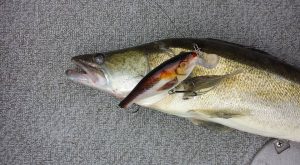 di pittura combinate portano a risultati davvero notevoli.
di pittura combinate portano a risultati davvero notevoli.
Mi chiamo Thorsten Baus e sono nato il 1965 a Solingen, in Germania. Sono felicemente sposato e padre di due figli. La pesca è la mia unica passione, oltre alla costruzione delle esche, con la pesca come ulteriore e più grande fattore di ricreazione. Godere della natura nelle prime ore del mattino, osservare l’aviofauna acquatica, riconoscere i pesci più difficili e lanciare per prenderli, ti fa dimenticare lo stress che spesso si incontra sul lavoro. La pesca è e resta la migliore terapia per me. Tight lines!
Da quanto peschi?
Quando ero piccolo potevo passare ore allo stagno… spesso e volentieri nel posto sbagliato, dove non c’erano pesci.
Quando hai iniziato a costruire? Ti ricordi la tua prima creazione?
Ho iniziato a costruire circa cinque anni fa e la mia prima esca è ancora nel mio armadio con acciacchi di tutti i tipi.
Perché hai iniziato ad autocostruire?
La ragione per cui ho iniziato con la costruzione di esche è stata la curiosità e il risparmio. Le esche buone sono molto costose e spesso di scarsa qualità.
Quando peschi che tecniche pratichi, dove e rivolte a che pesce?
A spinning, o casting, esclusivamente ai predatori. Durante le stagioni migliori per il topwater, jerk a lucci. Jig per i bass e i perca. In inverno invece a vertical su perca e bass. Questi tre predatori sono i più divertenti per me e sono molto comuni nella Germania occidentale.
Qual è il tuo più grande vizio?
Cosa significa vizio?
Qual è il materiale che ami di più? E quale tecnica di costruzione?
Costruisco le mie esche in legno e PU. E le rifinisco con tutti i tipi di foil e aerografo.
Nel corso degli anni, produttori e tecnologie hanno migliorato molto le nostre attrezzature da pesca, per te qual è stata la novità più utile e rilevante?
Blank veloci e mulinelli a bobina rotante giapponesi. E naturalmente lenze ottime.
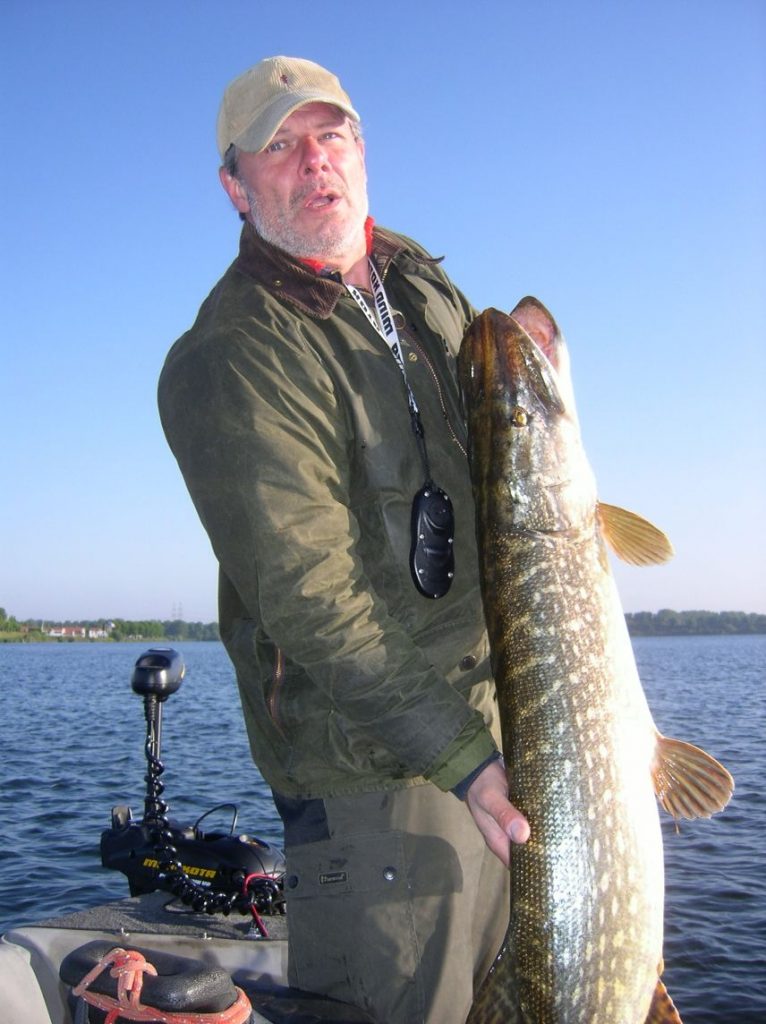
Qual è l’elemento che conta di più nel successo di un artificiale? Colore e realismo, equilibrio dei pesi e vibrazioni, forma e sua idrodinamica?
Tutti i componenti nella costruzione dell’esca sono importanti. Nessuno può essere trascurato. Solo l’interazione di tutti i fattori rende un’esca veramente ottima.
 Ci descrivi i principali processi e fasi della costruzione di un tuo artificiale?
Ci descrivi i principali processi e fasi della costruzione di un tuo artificiale?
La modellazione è molto importante. Successivamente mi occupo della profondità dell’acqua a cui deve viaggiare posizionando i pesi. Dipingo con aerografo e poi rivesto le esche con sei strati di epoxy.
Quanto tempo dedichi all’autocostruzione e quanto alla pesca?
È difficile da dire… Se ho tempo e voglia costruisco esche … se ho tempo e il meteo è buono vado a pescare.
Cos’è per te la pesca e cosa significa per te costruire esche?
Pace della mente.
Qual è la tua marca di esche artificiali presente sul mercato preferita?
Tutte le marche giapponesi sono di ottima qualità e sono molto fantasiose. Ci
sono costruttori di esche molto capaci in tutto il mondo… Questo fa si che gente con molto talento e passione in diversi paesi arrivi agli stessi risultati.
Qual è il tuo sogno di costruttore di esche?
Divertirmi e fare le cose con entusiasmo…………………….. pescare.
Se potessi scegliere un altro costruttore a cui affiancarti, presente o passato, il più bravo, chi sarebbe?
Ce ne sono tanti … dovrei vivere altri 500 anni… da spendere a guardarli lavorare da sopra la spalla.
Quali sono, nell’ordine, i primi materiali e attrezzi che consigli a chi vuole iniziare ad autocostruire? E con  quale imitazione partire?
quale imitazione partire?
Legno, carta vetrata, pazienza, calma … Nessun maestro è ancora caduto dal cielo.
Che consigli daresti a chi si avvicina all’autocostruzione?
Fidarsi e fare domande. Ci sono gruppi su Facebook in cui si ottengono risposte a tutte le domande… rispondono con piacere. Uno, per esempio è Hand made lures – Art of fishing.
Per vedere tutte le sue creazioni e scambiare due chiacchiere con lui potete contattarlo sulla sua pagina Facebook.
——————————————————————————————————————————————————–
My name is Thorsten Baus and I was born 1965 in Solingen Germany. I am happily married and father of two sons. Fishing is my only passion, besides the bait construction, with the fishing of the further larger recreational factor. To enjoy nature in the early morning hours, to observe the waterfowl, to recognize the stinging fish, and to throw them on, lets you forget the stress you often encounter in the job. Fishing is and remains the best therapy for me. Tight lines.

When did you start fishing?
I could spend as little young hours at the pond … very often on the wrong side where the fish were not standing.
How long ago did you start to build lures? Do you remember the first bait that you’ve created?
About five years ago I started with the bait construction and the first bait is still in my closet for mishaps of all kinds.
Why did you start to build baits?
The reason to start with baitbuilding was curiosity and profitability. Good baits are very expensive and often of poor quality.
 Which are the techniques of fishing you prefer? Where to fish? Which is the kind of fish you most like to catch?
Which are the techniques of fishing you prefer? Where to fish? Which is the kind of fish you most like to catch?
The fishing with casting rods and reels. Exclusively predatory. In the more active seasons topwater, jerk for pike. jigging for bass and pikepearch. In winter vertical on pikepearch and bass. These three predators are the most fun for me, and they are very common among the Dutch.
Which is your biggest vice?
What means vice?
Which is your favorite material to construct the baits? And what construction technique do you prefer?
I built my baits out of wood and PU. All kinds foiling and airbrush.
Over the years, the technology of fishing tackle are much improved. In your opinion which is the most important and useful innovation?
Fast blanks and Japanese baitcaster. And off course good strings.
Wich element most determines the success of a lure? Color and realism, weight balance and vibration, shape and hydrodynamics?
All components in bait construction are important. None may be neglected. Only the interaction of all factors makes a bait meaningful.
Can you describe the main building steps of your lures?
Shaping is very important. Subsequently, discharge the water depth with lead weights. Airbrushing and then coating the baits with six layers of epoxy.
How much time do you spend on building baits and how much on fishing?
That is hard to say … If i have time and fun I build baits …. if the weather is good and I have time i went fishing.
What does it mean for you fishing? And what does it mean for you to build lures?
Peace of mind.
What is your favorite brand of lures, including those on the market?
All Japanese brands are of very good quality and very imaginative. And there are very very good bait builders all over the world… that makes it only from… different countries and with them very talented people all the same passion.
What is your dream as a manufacturer of baits?
To have fun with life and the things one makes with enthusiasm… fishing.
If you could work with another manufacturer of lures – past or present – who would you choose?
Because there are so many… I would have to live another 500 years… to look at them at work over the shoulder.

What are the first materials and tools that you’d to advice to anyone who wants to start to build baits? And with what kind of imitation (crank, floating minnow, deep diver …)?
Wood, sandpaper, patience, calm ….. no master has fallen from the sky yet.
What advice would you give to those just beginning to build baits?
Trust you and ask questions. There are groups on Facebook in which one gets answered all questions… gladly answered. For example: Hand made lures – Art of fishing.



